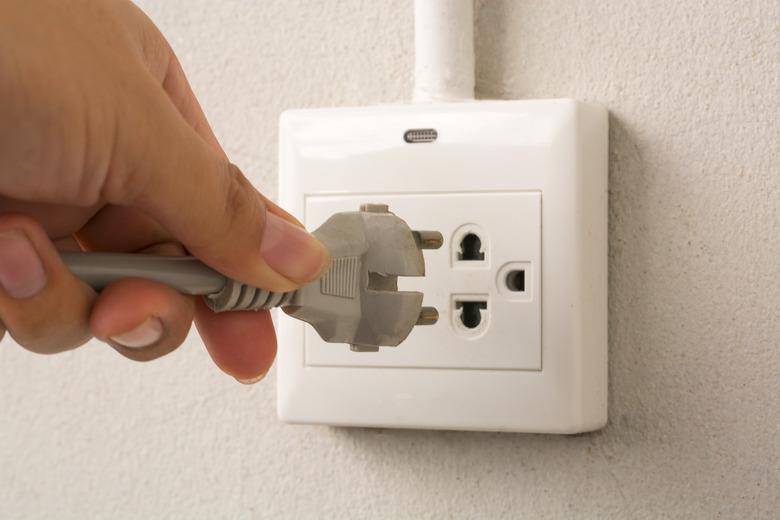How To Convert 220-Volt To 110-Volt Wiring
A 220V receptacle is usually required for large appliances, such as ranges, furnaces, and electric water heaters. It connects to the panel through a 220V circuit breaker rated for the current draw of the appliance via a 10-gauge or heavier cable with two hot wires, a neutral and – usually – a ground. Situations do arise in which the receptacle has to be converted from 220 volts to 110 volts. The most common situations are when you replace an electric range or dryer with a gas appliance. The 110-volt current is needed to power the controls and the lights on the new appliance.
You can convert a receptacle from 220 volts to 110 volts in one of two ways. The first is to use a 220 to 110 adapter. The other is to rewire the receptacle or install a new receptacle next to the old one and connect it to the 220-volt wiring. If you choose either of the second options, you'll have to install a new circuit breaker as 220V breakers are rated for more current than a 110V circuit can carry.
The Simple Solution: Use a 220 to 110 Adapter
An adapter that plugs into a standard 220-volt receptacle and allows you to use a 110-volt plug costs about $30. In technical terms, it provides a NEMA 5-15P outlet, which is a three-pin grounded outlet rated for 15 amps. It has an internal fuse that trips when the current exceeds 15 amps, so you don't need to change the circuit breaker. It doesn't have ground fault protection, however, so you shouldn't use it in a location in which a GFCI is required, such as the laundry room. Commonly called a gas range adapter, it's an easy and effective way to convert a 220V receptacle for use as a 110V outlet when the outlet is behind a range and safely out of the way of moisture.
Tip
You may not be able to find a 220 to 110 adapter. Instead, you may find a 240 to 120 one or even a 250 to 125. Don't worry. Any of them will work. Electrical manufacturers and electricians use the different numbers because the standard voltage coming into residential panels from the power lines can vary.
Rewiring a 220V Receptacle Starts at the Outlet Box
Before you do any electrical wiring, be sure the breaker controlling the circuit is off. It's also a good idea to turn off the main panel breaker, after arranging for an alternate light source, but remember that the panel bus bars are still energized even when you do this. This job requires changing a breaker, so if you aren't comfortable working in the panel, get an electrician to do it.
It's best to start the replacement at the receptacle.
- Unscrew it from the box and disconnect the wires. In most cases, 220 wire has a red and black hot conductor, a white neutral and a bare or green ground.
- You only need one hot wire for the new receptacle, so screw a wire cap onto the red wire and push it back in the box. Keep in mind that 10-gauge wires can't connect directly to a 110-volt 15- or 20-amp receptacle because it's designed to accept only 12-gauge or smaller wires. A good way to get around this is to pigtail short lengths of 12-gauge wire onto the 10-gauge circuit wires, a process that involves twisting the 10- and 12-gauge wires together and screwing on a wire cap to create 12-gauge terminal wires.
- After forming the pigtails, attach the 12-gauge black wire to one of the brass terminal screws, the 12-gauge white wire to the corresponding chrome screw and the 12-gauge green or bare wire to the ground screw. When you're done, screw the receptacle to the electrical box and install a cover plate.
Installing a New Circuit Breaker
After you've installed the new receptacle, return to the main panel and pull out the double-gang breaker that was controlling the circuit.
- Disconnect the wires, cap the red one, and push it safely back into the panel.
- Connect the white wire to the neutral bus and the ground wire to the ground bus.
- Finally, connect the black wire to a single-pole breaker rated for either 15 or 20 amps, depending on the receptacle rating. Push it into one of the slots occupied by the double-pole breaker you removed.
You're now ready to turn on the breakers and use the receptacle.
